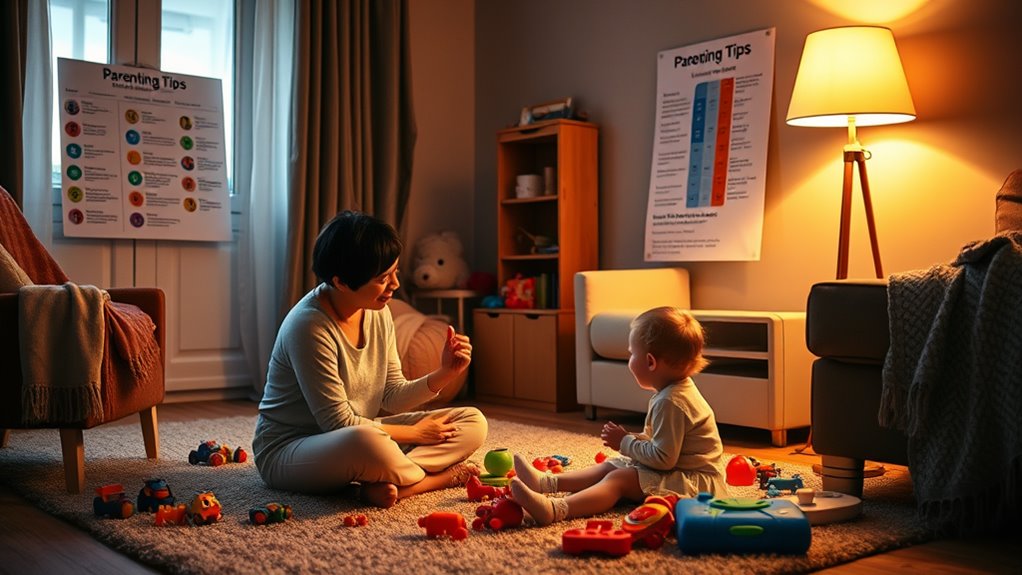The One Parenting Tip Experts Swear By for Better Behavior!
The one parenting tip experts swear by for better behavior is positive reinforcement. By acknowledging and rewarding your child’s good actions, you encourage them to repeat those behaviors. Instead of focusing on the negative, highlight what’s right. Offer specific praise or small rewards immediately after the desired action to boost their confidence and build a nurturing environment. Set clear goals and track progress visually to keep motivation high. This approach not only improves behavior but also strengthens your relationship with your child. Discover how to implement these strategies effectively to create lasting change in their behavior.
Understanding Positive Reinforcement
Positive reinforcement is a powerful tool in shaping your child’s behavior. It involves acknowledging and rewarding positive actions, which encourages your child to repeat those behaviors. Instead of focusing on what your child does wrong, you’ll find that highlighting the good can lead to more lasting changes.
When your child shares their toys or completes a chore, acknowledge their behavior with praise or a small reward. This affirmation helps them associate good behavior with positive outcomes, fostering a sense of pride and motivation. You might say, “I really appreciate how you helped clean up!” This kind of recognition can boost their confidence and encourage them to continue those actions.
It’s important to be specific in your praise. Instead of just saying, “Good job,” explain what they did well. For instance, “You did a great job listening during storytime,” makes the positive feedback more impactful.
Consistency is key, so try to reinforce good behavior regularly. By doing this, you create an environment where your child feels valued and understood, paving the way for better behavior and a stronger relationship between you both.
Scientific Backing for Positive Reinforcement
Research supports the effectiveness of positive reinforcement in shaping children’s behavior. Numerous studies demonstrate that when you reward your child for good behavior, it significantly increases the likelihood of that behavior being repeated. This approach taps into basic psychological principles, such as operant conditioning, where positive outcomes encourage repetitions of specific actions.
When you provide praise, rewards, or other incentives, your child learns to associate positive feelings with their actions. For instance, a child who receives compliments for sharing toys is more likely to continue sharing in the future. This method not only promotes desired behaviors but also fosters a positive emotional climate in your home.
Experts emphasize the importance of immediacy in reinforcement; the closer the reward is to the behavior, the stronger the connection your child will make. You’ll want to ensure that the reinforcement is meaningful to your child, whether it’s verbal praise, stickers, or extra playtime.
Practical Examples of Positive Reinforcement
Building on the effectiveness of positive reinforcement, you can implement practical strategies that make this approach work in your everyday parenting. Here are a few examples to consider:
| Behavior | Reinforcement |
|---|---|
| Completing homework | Offer praise or a small treat |
| Sharing toys with siblings | Allow extra playtime or a fun outing |
| Helping with chores | Give a sticker or a special privilege |
When your child completes homework, express genuine praise or offer a small treat to reinforce their effort. This not only recognizes their hard work but encourages them to continue. If they share toys with siblings, consider rewarding them with extra playtime or a fun outing. This way, they associate sharing with positive experiences.
Lastly, when your child helps with chores, a simple sticker can make a big impact, or granting a special privilege can further motivate them. Remember, consistent application of these reinforcements can lead to lasting behavioral improvements. Positive reinforcement isn’t just about rewarding; it’s about building a nurturing environment that encourages good behavior.
Step-by-Step Implementation Guide
Implementing positive reinforcement effectively requires a clear and structured approach. Start by identifying specific behaviors you want to encourage in your child. For example, if you want them to complete their homework, make that your focus.
Next, set achievable goals. Break down the desired behavior into small, manageable tasks. This way, your child can experience success and feel motivated to continue.
Once you’ve established goals, choose appropriate rewards. These can range from verbal praise to small treats or extra playtime. Tailor the rewards to what your child values most, as this will increase their motivation.
Now, be consistent. Whenever your child exhibits the desired behavior, promptly reinforce it with the chosen reward. This helps them make the connection between their actions and the positive outcomes.
Keep track of progress by maintaining a chart or log. This visual representation serves as a reminder of their achievements and helps reinforce the behavior over time.
Finally, review and adjust your approach as needed. As your child grows and develops, their interests and motivations may change, so stay flexible to ensure continued success.
Common Challenges and Solutions
Navigating the journey of positive reinforcement can sometimes run into bumps along the road. You might face challenges like inconsistency, lack of immediate feedback, or even misunderstanding what behaviors to reinforce. Recognizing these hurdles is the first step toward overcoming them and ensuring your approach remains effective.
Here’s a quick reference table to help you identify common challenges and their solutions:
| Challenge | Solution |
|---|---|
| Inconsistent reinforcement | Set clear rules and stick to them |
| Delayed feedback | Provide immediate praise or rewards |
| Confusion about behaviors to reinforce | Create a specific list of target behaviors |
| Over-reliance on rewards | Introduce intrinsic motivation strategies |
| Resistance from your child | Involve them in setting goals and rewards |
Long-Term Benefits of Positive Reinforcement
Positive reinforcement can lead to remarkable long-term benefits for both you and your child. When you consistently acknowledge and reward positive behavior, you’re not just shaping immediate actions; you’re also fostering a supportive environment that encourages growth. Your child will develop a stronger sense of self-esteem and confidence, knowing their efforts are recognized and valued.
Moreover, this approach builds a positive parent-child relationship. By focusing on what your child does right, you create a bond that encourages open communication. They’ll feel more comfortable discussing their feelings and challenges with you, knowing you’re their ally.
In addition, positive reinforcement instills valuable life skills. As your child learns to associate good behavior with rewarding outcomes, they’re more likely to make responsible choices in the future. This skill extends beyond childhood, helping them navigate relationships, academic challenges, and career opportunities later in life.
Ultimately, employing positive reinforcement today shapes your child into a well-adjusted adult tomorrow. You’ll find that the time and effort you invest in praising their good behavior pays off in spades, creating a harmonious home filled with mutual respect and understanding.
Frequently Asked Questions
Can Positive Reinforcement Be Used With Teenagers Effectively?
Absolutely, you can use positive reinforcement with teenagers effectively. By recognizing their achievements and encouraging desired behaviors, you’ll foster a supportive environment that motivates them to make better choices and feel valued.
What Are Some Negative Effects of Misusing Positive Reinforcement?
Misusing positive reinforcement can lead to entitlement, dependency on rewards, or manipulation. You might find your teen expecting rewards for basic behaviors, undermining their intrinsic motivation and creating an unhealthy dynamic in your relationship.
How Does Positive Reinforcement Differ From Bribery?
Positive reinforcement encourages desired behaviors by rewarding them, while bribery offers an incentive to engage in specific actions, often in a manipulative way. You’ll notice the difference in intent and long-term effects on behavior.
Is Positive Reinforcement Effective for Children With Special Needs?
Absolutely, positive reinforcement can be very effective for children with special needs. It encourages desired behaviors by rewarding achievements, helping them feel valued and motivated. Tailoring rewards to their interests enhances the impact even further.
Can Positive Reinforcement Be Applied in a Classroom Setting?
Absolutely, you can apply positive reinforcement in a classroom setting. By acknowledging and rewarding desired behaviors, you encourage students to repeat those actions, creating a more engaging and supportive learning environment for everyone involved.





